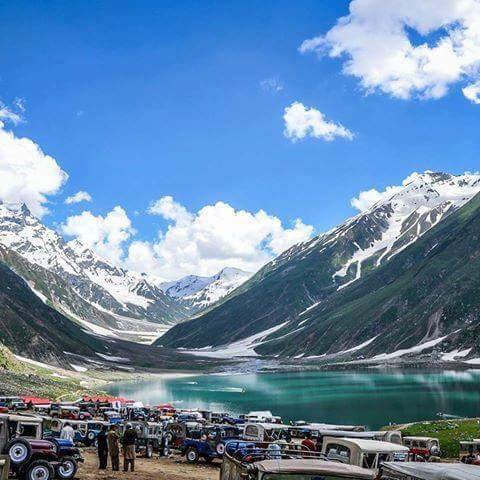
Lake Saif-ul-Malook – ranked by The Guardian as the fifth best tourist
destination in Pakistan – seems like heaven on earth. The
greenish-blue crystal clear and freezing water, surrounded by giant
glaciers, including Malika Parbat, reflects the beauty of
Saif-ul-Malook.
Location
The divine lake lies at the northern end of the Kaghan Valley near
Naran, and in the north east of Mansehra district of Khyber
Pakhtunkhuwa. It is the highest alpine lake of Pakistan at an altitude
of 3,224 metres and 10,578 feet above sea level.
Leisure activities for tourists
The lake is kind of a bowl where multiple glacial waters accumulate.
However, it consists of large eco-diversity which includes a rare
brown trout fish, bulk amount of blue-green algae, and a variety of
water-plants and phytoplankton. Trout fishing is quite popular in
Kaghan and in Naran as well.
The magical lake is completely frozen during winters due to heavy
snowfall. The ideal time for tourists starts from June to September.
The weather of this divine place is extremely pleasant during day time
(about 15-20 degree centigrade), whereas at night the temperature
drops to three degrees centigrade.
Boating facility is also available for adventure enthusiasts. The
experience may be full of excitement but one should be careful because
the lake’s depth is still unknown, and there aren’t rescue equipments.
So do boating at your own risk! Ponies and horses are also available
if one doesn’t want to travel on foot.
Camping at the time of the full moon is like sitting in a fairyland.
It is highly recommended for those who want to see the moon shining at
it brightest amongst five billion stars in the sky.
Fairy tale of Saif-ul-Malook
The history of this exquisite lake is much famous and attracts the
tourists from all over the world. The story is about a prince,
Saif-ul-Malook, who fell in love with a fairy princess, Badi-ul-Jamal.
The tale was transformed into a poem by Sufi saint and Punjabi Hindko
poet, Mian Muhammad Bakhsh. The same poem was translated into Urdu
language by a resident of Balakot, Ahmed Hussain Mujahid. According to
the locals it is a place of fairies and demons, who through the
extremity of weather display their anger.
A story teller narrated: “I have not seen the fairy, but I’ve seen the
glory of God. Every month, on the 14th night of the lunar month, the
lake is like a mirror – cradling the mountains, the sky, the
innumerable twinkling stars, the glowing orb of the moon – so still,
so clear, you can scarcely tell the between reality and reflection. It
is a sight to behold! Many a night I have also seen lights, floating
lights, a thousand floating lights, here on the slope, where and
watched them disappear under the rocks. I have not seen the fairy,
Badi-ul-Jamal, but I have witnessed the glory of God.”
Saif-ul-Malook was a prince of Egypt. He had a handsome amount of
treasure which he inherited from his forefathers. Inscribed on the
treasure were two seals; one bearing the